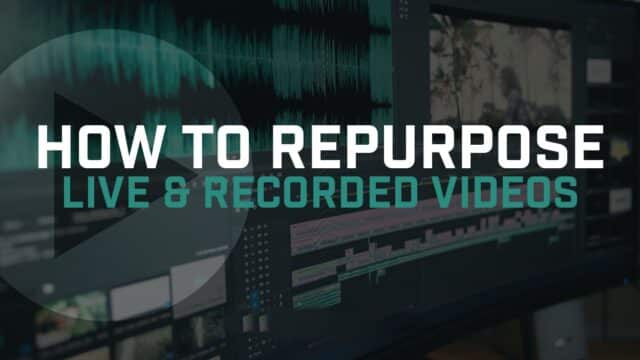
Podcasting 101
So you’re thinking about doing a podcast, huh?
It makes sense. Over the past few years, the podcast medium has exploded with growth and popularity. In the busy world we live in, podcasts are great for long commutes, trips to the gym, or even running errands around town.
Your church might already be podcasting your weekend sermons, and that’s great. But with the growth of the medium, several churches are starting to branch out and launch other podcasts to try to reach new audiences or further disciple their congregations.
This can look different depending on the makeup of your church and the talents of your staff. I’ve seen churches try shows similar to Craig Groeschel’s Leadership Podcast where the senior pastor or other prominent leader shares insight on leadership or other popular topics. Other churches, like Bayside Church in California, host shows like The Flip/Side, which is an informal show with a few co-hosts to go deeper on the weekend teaching. Or maybe you decide to offer a series of discipleship or newcomers’ classes as free audio or video downloads.
There are several ways your church could take advantage of this growing medium. And just like anything else new, this can feel like a big and scary undertaking.
When I started out, even though I had some experience in radio, I did not know much about podcasting. It took longer than I expected to get it off the ground.
Before you take the plunge, let me share a few things I’ve learned while hosting The Making Sunday Happen Podcast for over four years and more than 250 episodes. Your church’s podcast will likely look different than mine, and some of these questions may not be relevant for the content of your show. Still, here are 10 tips and tricks I’ve learned along the way that may be helpful for you.
1) START WITH WHY
When deciding on whether to host a podcast, you need to first ask yourself “why?” You will probably find that with everything involved in producing and distributing a podcast, it is going to take longer and require much harder work than you might realize.
Start by asking yourself:
☐ What do I have to say?
☐ Is this a hobby or am I building a platform?
☐ Why am I doing this?
Take some time to think through why you’re hosting a podcast and develop a plan of attack for it. Think it through and write down some goals.
2) CREATE A THEME
I would suggest creating a theme for your podcast and filter each topic or show through the lens of that theme.
Here is mine: The Making Sunday Happen Podcast is the definitive podcast for helping church leaders and volunteers who plan, create, and execute worship experiences at churches around the world.
Simply put: We help you transform your worship experience.
Everything must filter through that theme. I ask the question, “Does this topic/guest/question help church leaders transform their worship experience?”
If the answer is no, it doesn’t get on the podcast.
I’ve made some exceptions and some mistakes getting there. I’ve let some things pass through that filter when I should not have, but the more I am at it, the more focused I am about making sure everything fits through the filter.
This may mean you need to say “no” to incredible guests or topics because they do not pass through your filter.
(Hint: You might still do the interview if it is worth it, but put it somewhere else, like your personal social media pages or other platform.)
Be protective of your filter.
3) KNOW YOUR FORMAT AND LENGTH
☐ Is this a podcast of only you, or you and a co-host talking?
☐ Is this a podcast mostly consisting of you interviewing a guest?
☐ What is the desired length of each episode?
☐ Is it audio only or video?
☐ What is the framework of your show?
Have a Show Layout
I have a template that I use for almost every episode of our podcast. I might add a few little extras every now and then, but for the most part, here is my flow:
Teaser: I introduce the episode number and name.
Show Open: This is a pre-made introduction to our show.
Intro: I give a brief introduction to the show and the topic of the episode.
Commercial Spot #1: I share a sponsor video or talk about the sponsor of the episode.
Interview or Main Content: This is the meat of the episode. This is where I share my interview or primary material.
Commercial Spot #2: This spot is for another commercial, a plug for our platform, a plug for our episode show notes, or other promotional material.
Closing and Mailbag Segment: This is where I close out the episode with information about where they can find more about the show and the topic and what’s coming the next week. I also take this segment to answer any questions from listeners.
Show Close: This is a pre-made show close sharing our website and other information about our ministry.
Landing Interviews
The number one question I usually get about our podcast is “How did you get [INSERT NAME] to be on your podcast!?”
We have had some notable guests on our program including Steven Curtis Chapman, Phil Vischer (VeggieTales), Kirk Cameron, Kevin and Sam Sorbo, Alex Kendrick, Joel Smallbone (For King and Country), and others.
So what is the secret sauce? You ready for it? Ask.
Seriously, build your platform and ask.
I’ve sent hundreds of emails to potential guests for the podcast. Some say “yes,” some say “no.” I’ve been turned down by dozens of people, but I don’t let that stop me. I keep asking other people, and as our platform grows, people that said “no” a year ago, might say “yes” after they’ve seen who else we’ve gotten on the show.
Here are some other tricks:
☐ If you can catch artists and others when they are promoting their new project (new album, new book, new movie, etc.), they are more likely to come on your show.
☐ If you can build relationships with any public relations company that promotes content from artists, do it. Get on their email list. Talk to people.
At this point for us, after over 250 episodes, we have so many emails from public relations companies pitching their artists to be on our show, we turn down dozens each month. How do we determine who we say yes to? Our filter! If we can’t find an angle to ask them questions about how to transform a worship experience, they don’t get on the show. Period.
4) BE CONSISTENT
Are you going to produce a monthly podcast? Weekly? Seasonal? Decide that now and stick to it. I would suggest picking from one of these three options:
☐ Weekly
☐ Monthly
☐ Seasonal
I would not suggest you releasing episodes “when you can.” Be consistent with your audience. Tell
them when to expect content.
If your show is weekly, you better release a show every week on the same day. If you don’t, you will lose your audience.
When in doubt, I would produce less content and increase the amount later, rather than promise content and not deliver.
5) PRODUCE IN BULK
The second most frequently asked question I get when it relates to our podcast is “How do you guys produce so much content?”
Here’s the trick: We produce in bulk.
We map out our podcast calendar for months and months in advance. While I am writing this, we know exactly what podcast episodes will air, with what guest, who is sponsoring the episode, and more, for the next eight months (that’s 32 episodes if you’re counting).
We may not have the segments or interviews recorded, but we know exactly where we are going.
This doesn’t mean we do not change the calendar if we need. We move things around if we need to. But we have a plan and adjust the plan as we go.
It is much easier to tweak the calendar than to create the calendar each week.
6) OUTSOURCE YOUR EDITING
One method that allows you to produce a lot of high quality episodes and for you to focus on the content for each show is to outsource the audio or video editing of your podcast.
Our ministry at Twelve:Thirty Media produces both audio and video podcasts for several ministries and networks with incredible motion graphics openers and material.
Here are a couple to check out:
☐ The Making Sunday Happen Podcast (Audio and Video)
☐ The Vanderbloemen Leadership Podcast (Audio Only)
☐ Together for Good Podcast (Audio and Video)
☐ The Everyday Christian Podcast (Graphics Package)
Our team of audio composers and motion designers can produce every episode of your show. All you would have to provide is your audio and video recordings and we can do everything else. Contact us to learn how we can help you.
Even if you do not use Twelve:Thirty Media, I would strongly suggest you focus on the primary content of your podcast, and let others produce each episode for you.
7) GEAR
You’ll want to spend a little bit of money getting good gear to capture a solid recording. Here are a couple of podcast starter kits for under $300:
You can use the built-in camera on your laptop if you need to record video.
Both audio and video are very important, but I would focus more on getting quality audio than anything.
Again, with outsourcing the editing of your podcast, all you need to do is have a great setup, capture great audio and video, and send your files to your editor.
8) DISTRIBUTION
There are several great podcasting platforms that you can host your podcast with that will take care of distributing your audio or video files to all the platforms you would like your podcast on.
Here are my recommendations:
☐ Podbean
9) PROMOTION
You’ll want to spend some time promoting and sharing your podcast.
☐ Social media. Be sure to create social media accounts for your platform where you can share each podcast episode and material from each guest.
☐ Email. Use a service like MailChimp to create an email list where you can send fresh episodes of your podcast to your audience straight to their inbox.
10) REPURPOSE
Another trick to accomplishing more is to find as many ways to repurpose your podcast content as you possibly can.
Use the content from your podcast for:
☐ Blog posts
☐ Smaller segments for social media
☐ Social media quotes
☐ Ebooks
Most of the time, your audience is not going to consume your content the same exact way. Some people like to read, some like to listen, some like to watch. Take advantage of this and repurpose one piece of content in as many ways as you can think of.
It is my prayer that your podcast will be a great tool for you to reach your audience!




